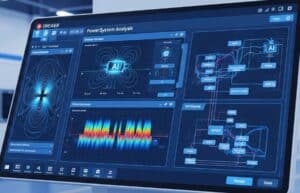
تُحدث أدوات الذكاء الاصطناعي عبر الإنترنت تحولاً سريعًا في الهندسة الكهربائية من خلال زيادة القدرات البشرية في تصميم الدوائر الكهربائية وتحليل الأنظمة والإلكترونيات التصنيعوصيانة أنظمة الطاقة. يمكن لأنظمة الذكاء الاصطناعي هذه معالجة كميات هائلة من بيانات المحاكاة وقراءات المستشعرات وحركة مرور الشبكة، وتحديد الحالات الشاذة المعقدة أو اختناقات الأداء، وإنشاء طوبولوجيا جديدة للدوائر أو خوارزميات التحكم بشكل أسرع بكثير من الطرق التقليدية. على سبيل المثال، يمكن للذكاء الاصطناعي مساعدتك في تحسين تخطيطات ثنائي الفينيل متعدد الكلور من أجل سلامة الإشارة وقابلية التصنيع، وتسريع عمليات المحاكاة الكهرومغناطيسية أو محاكاة تدفق الطاقة المعقدة، والتنبؤ بخصائص أجهزة أشباه الموصلات، وأتمتة مجموعة واسعة من معالجة الإشارات ومهام تحليل البيانات.
ستساعد المطالبات المقدمة أدناه، على سبيل المثال، في التصميم التوليدي للهوائيات أو المرشحات، وتسريع عمليات المحاكاة (SPICE، ومحاكاة المجال الكهرومغناطيسي، وتحليل استقرار نظام الطاقة)، والمساعدة في الصيانة التنبؤية حيث يحلل الذكاء الاصطناعي بيانات المستشعرات من محولات الطاقة أو مكونات الشبكة للتنبؤ بالأعطال المحتملة، مما يتيح الصيانة الاستباقية وتقليل وقت التعطل، والمساعدة في اختيار مواد أشباه الموصلات أو الاختيار الأمثل للمكونات (على سبيل المثال، اختيار أفضل مصباح تشغيل لمعلمات محددة)، وغير ذلك الكثير.
- هذه الصفحة خاصة بنطاق واحد. إذا لزم الأمر، يمكنك الحصول على إمكانيات بحث كاملة حسب جميع المجالات وجميع المعايير في > دليل موجهات الذكاء الاصطناعي <، مخصص لـ تصميم المنتج و ابتكار.
- نظرًا لموارد الخادم والوقت، فإن المطالبات نفسها محجوزة للأعضاء المسجلين فقط، ولا تظهر أدناه إذا لم تكن مسجلاً. يمكنك التسجيل، 100% مجاناً:
- مراجعة الأدبيات وتحليل الاتجاهات
- الهندسة الكهربائية
موجه الذكاء الاصطناعي إلى براءات الاختراع الأساسية في نقل الطاقة اللاسلكي
- التصميم من أجل الاستدامة, الهندسة الكهربائية, الطاقة, ابتكار, الملكية الفكرية, تطوير المنتجات, الطاقة المتجددة, ممارسات الاستدامة
يحدد ويلخص براءات الاختراع الأساسية الرئيسية في مجال محدد من تكنولوجيا نقل الطاقة اللاسلكية (WPT) ويلخصها مع تسليط الضوء على ابتكاراتها الأساسية وتأثيرها على هذا المجال. يساعد ذلك المهندسين على فهم المشهد التأسيسي للملكية الفكرية. المخرجات عبارة عن قائمة CSV لبراءات الاختراع.
المخرجات:
- CSV
- يتطلب إنترنت مباشر
- المجالات: {WPT_technology_technology_focus} {مجال_التطبيق_مجال_التطبيق_اختياري} {عدد_براءات_الاختراع_للعثور}
Act as a Patent Technology Scout specializing in Electrical Engineering innovations.
Your TASK is to identify and summarize key/seminal patents related to `{wpt_technology_focus}` (e.g.
'Resonant Inductive Coupling for EV Charging'
'Near-Field Capacitive WPT'
'Microwave Power Beaming for Drones'
'Ultrasonic WPT for Medical Implants').
Optionally
filter by `{application_area_filter_optional}` (e.g.
'Automotive'
'Consumer Electronics'
'Medical Devices'
'Industrial Automation') if specified.
Aim to find approximately `{number_of_patents_to_find}` significant patents. This may include foundational patents or highly cited ones that introduced key concepts.
You MUST use live internet access to search patent databases (e.g.
Google Patents
USPTO
Espacenet).
**PATENT IDENTIFICATION AND SUMMARY (Output as CSV String):**
**CSV Header**: `Patent_Number
Title
Publication_Date
Assignee_Original
Key_Inventors
Core_Innovation_Summary
Perceived_Impact_or_Significance
Patent_URL`
**Search and Analysis Process:**
1. **Keyword Formulation**: Develop search queries based on `{wpt_technology_focus}`
relevant technical terms
and potentially `{application_area_filter_optional}`.
2. **Database Search**: Query patent databases. Look for patents with early priority dates for foundational concepts
or those with high citation counts
or those frequently referenced in review articles on WPT.
3. **Patent Review**: For promising candidates
review the abstract
claims (especially independent claims)
and description to understand the core innovation.
4. **Selection**: Select up to `{number_of_patents_to_find}` patents that appear most seminal or impactful based on their claims
problem solved
and influence (e.g.
if they enabled a new product category or solved a major technical hurdle).
**Data Extraction for each selected patent:**
* **Patent Number**: (e.g.
USXXXXXXX B2)
* **Title**: Full title of the patent.
* **Publication Date**: Date of grant or first major publication.
* **Assignee (Original)**: The company or institution it was originally assigned to.
* **Key Inventors**: List one or two primary inventors if easily identifiable.
* **Core Innovation Summary**: A concise (1-2 sentences) explanation of what the patent claims as its main invention in the context of `{wpt_technology_focus}`.
* **Perceived Impact or Significance**: Why is this patent considered important or seminal? (e.g.
'Pioneered the use of coupled magnetic resonators for mid-range WPT'
'Solved a key safety/efficiency issue'
'Underpins many commercial WPT charging systems').
* **Patent URL**: A direct link to view the patent (e.g.
Google Patents link).
**Example CSV Row (Conceptual):**
`US7741734B2
Wireless power transfer systems
2010-06-22
WiTricity Corporation
Kurs
Andre; Karalis
Aristeidis
Utilizes coupled resonant objects to efficiently transfer power over mid-range distances without direct contact
a key enabler for resonant inductive WPT technology.
Seminal patent for mid-range resonant WPT
heavily licensed and cited.
https://patents.google.com/patent/US7741734B2`
**IMPORTANT**: The selection of "seminal" can be subjective. Focus on patents that introduced foundational concepts or had a clear and demonstrable impact on the field of `{wpt_technology_focus}`. Provide direct URLs to the patent documents.
- الأفضل لـ تحديد وتلخيص براءات الاختراع الأساسية في تقنيات محددة لنقل الطاقة اللاسلكية (WPT) التي تساعد المهندسين الكهربائيين على فهم الملكية الفكرية التأسيسية والابتكارات الرئيسية.
- تقييم المخاطر وتحليل السلامة
- الهندسة الكهربائية
موجه الذكاء الاصطناعي إلى Evaluate Safety Measures for Electrical Design
- تقييم التصميم, التصميم من أجل الاستدامة, التوصيل الكهربائي, الهندسة الكهربائية, المقاومة الكهربائية, إدارة المخاطر, أمان, المعايير
This prompt directs the AI to evaluate the effectiveness of specified safety measures in an electrical design based on provided design details and standards. The user inputs design features and relevant safety standards.
المخرجات:
- تخفيض السعر
- لا يتطلب إنترنت مباشر
- Fields: {design_features} {safety_standards}
Given the electrical design features:
{design_features}
and the following safety standards:
{safety_standards}
evaluate the adequacy of the implemented safety measures. Provide a detailed markdown report with sections for compliance, potential weaknesses, and recommendations for improvement. Use bullet points and bold important terms.
- Best for: Best for compliance checking and improving design safety
- تقييم المخاطر وتحليل السلامة
- الهندسة الكهربائية
موجه الذكاء الاصطناعي إلى Quantitative Risk Analysis for Electrical Systems
- الهندسة الكهربائية, تحليل الفشل, تحليل نمط الفشل والآثار (FMEA), خوارزميات الصيانة التنبؤية, تحسين العمليات, إدارة الجودة, تحليل المخاطر, إدارة المخاطر, أمان
This prompt asks the AI to perform a quantitative risk analysis on a specified electrical system, using input data like failure rates and exposure times. The user inputs failure data and system parameters.
المخرجات:
- CSV
- لا يتطلب إنترنت مباشر
- Fields: {failure_rates_data} {system_parameters}
Using the following failure rates data in CSV format:
{failure_rates_data}
and system parameters:
{system_parameters}
calculate quantitative risk metrics such as Failure Probability, Risk Priority Number (RPN), and expected downtime. Return a CSV table with columns: Component, FailureRate, Severity, Occurrence, Detection, RPN, MitigationActions. Explain calculations briefly in comments if possible.
- Best for: Best for data-driven risk quantification and prioritization
- تقييم المخاطر وتحليل السلامة
- الهندسة الكهربائية
موجه الذكاء الاصطناعي إلى Suggest Mitigation Strategies for Electrical Hazards
- التوصيل الكهربائي, الهندسة الكهربائية, المقاومة الكهربائية, تحليل نمط الفشل والآثار (FMEA), دراسة المخاطر وقابلية التشغيل (HAZOP), تحسين العمليات, إدارة الجودة, إدارة المخاطر, أمان
This prompt enables the AI to suggest practical mitigation strategies for identified electrical hazards in a given setup. The user provides the hazard list and system context.
المخرجات:
- النص
- لا يتطلب إنترنت مباشر
- Fields: {hazard_list} {system_context}
Given the following list of electrical hazards:
{hazard_list}
and the system context:
{system_context}
suggest detailed and practical mitigation strategies to reduce risks. Include engineering controls, administrative controls, and personal protective equipment recommendations. Structure the response with headings and bullet points.
- Best for: Best for improving workplace and design safety measures
- Simulation Setup and Parameterization
- الهندسة الكهربائية
موجه الذكاء الاصطناعي إلى SPICE MOSFET Model Parameter Tuning
- التصميم من أجل التصنيع (DfM), تحسين التصميم, الهندسة الكهربائية, MOSFET, تتبع الأداء, تطوير المنتجات, مراقبة الجودة, المحاكاة
Guides the AI to suggest SPICE model parameter adjustments for a specified MOSFET to better match its datasheet or target application performance. This aids in creating more accurate simulations for circuit design. The output is a JSON object with suggested parameter values and rationale.
المخرجات:
- JSON
- يتطلب إنترنت مباشر
- Fields: {mosfet_part_number_or_datasheet_url} {target_application_focus} {key_performance_metrics_to_match_csv}
Act as a Semiconductor Device Modeling Engineer.
Your TASK is to suggest SPICE model parameter adjustments for the MOSFET identified by `{mosfet_part_number_or_datasheet_url}` to better align its simulation behavior with datasheet specifications or the needs of a `{target_application_focus}` (e.g.
'High-frequency SMPS'
'RF amplifier stage'
'Low RDS(on) switching').
The goal is to match key performance metrics listed in `{key_performance_metrics_to_match_csv}` (e.g.
'RDS(on)_at_Vgs=10V
Gate_Threshold_Voltage_Vth
Total_Gate_Charge_Qg
Output_Capacitance_Coss
Switching_Times_tr_tf').
**ANALYSIS AND SUGGESTION LOGIC:**
1. **Datasheet Review (if URL/Part Number provided for live access):**
* Attempt to fetch and review the datasheet for `{mosfet_part_number_or_datasheet_url}`.
* Extract typical values for the `{key_performance_metrics_to_match_csv}`.
2. **Identify Key SPICE Parameters:**
* Based on a standard MOSFET model (e.g.
LEVEL 1
LEVEL 3
BSIM)
identify SPICE parameters that MOST STRONGLY influence the `{key_performance_metrics_to_match_csv}`. Examples:
* `VTO` (Zero-bias threshold voltage) -> Vth
* `KP` (Transconductance parameter)
`LAMBDA` (Channel-length modulation) -> RDS(on)
I-V curves.
* `CGSO`
`CGDO`
`CGBO` (Gate overlap capacitances) -> Qg
Coss
Crss.
* `RD`
`RS` (Drain/Source ohmic resistances) -> RDS(on).
* `TOX` (Gate oxide thickness) -> Affects VTO
capacitances.
* Parameters influencing switching times (internal resistances
capacitances).
3. **Suggest Adjustments:**
* For each relevant SPICE parameter
suggest a direction for adjustment (increase/decrease) or a target range if a generic model is being tuned.
* Provide a brief RATIONALE for each suggested adjustment
linking it back to the `{key_performance_metrics_to_match_csv}` and `{target_application_focus}`.
* If a specific SPICE model level is assumed (e.g.
BSIM4)
mention it.
**OUTPUT FORMAT (JSON):**
Return a single JSON object structured as follows:
`{
"mosfet_model_tuning_suggestions": {
"target_mosfet": "`{mosfet_part_number_or_datasheet_url}`"
"assumed_spice_model_level": "[e.g.
BSIM4
Level 3
Generic Power MOSFET]"
"parameter_adjustments": [
{
"spice_parameter": "VTO"
"suggested_value_or_adjustment": "[e.g.
Target 2.5V based on datasheet Vth
or 'Slightly decrease if simulated Vth is too high']"
"rationale": "Directly impacts gate threshold voltage
critical for matching turn-on characteristics for `{target_application_focus}`."
"related_metric": "Gate_Threshold_Voltage_Vth"
}
{
"spice_parameter": "KP"
"suggested_value_or_adjustment": "[e.g.
Increase if simulated RDS(on) is too high]"
"rationale": "Impacts channel conductivity and thus RDS(on) and current handling."
"related_metric": "RDS(on)"
}
{
"spice_parameter": "CGDO"
"suggested_value_or_adjustment": "[e.g.
Adjust to match Miller plateau in Qg curve or Crss from datasheet]"
"rationale": "Gate-Drain capacitance significantly affects switching speed and total gate charge."
"related_metric": "Total_Gate_Charge_Qg
Switching_Times_tr_tf"
}
// ... more parameter suggestions ...
]
"general_tuning_notes": "Start with major DC parameters (VTO
KP
RDS(on))
then refine AC/switching parameters (capacitances
gate resistance). Iterative adjustments and comparison with datasheet curves are recommended. Consider temperature effects if relevant for `{target_application_focus}`."
}
}`
**IMPORTANT**: The suggestions should be practical for an engineer working with SPICE models. If the AI cannot access the datasheet
it should base suggestions on general knowledge of MOSFET parameters and their influence on the listed metrics.
- Best for: Assisting electrical engineers in fine-tuning SPICE model parameters for MOSFETs to achieve more accurate simulations tailored to specific applications and performance metrics.
- Simulation Setup and Parameterization
- الهندسة الكهربائية
موجه الذكاء الاصطناعي إلى Phased Array Antenna Simulation Setup
- الفضاء الجوي, ديناميكيات الموائع الحسابية (CFD), التصميم من أجل التصنيع الإضافي (DfAM), تحسين التصميم, الهندسة الكهربائية, الكهرومغناطيسية, المحاكاة
Outlines the key steps and parameters for setting up an electromagnetic simulation of a phased array antenna aiming to compute its far-field radiation pattern and scan performance. This prompt helps antenna engineers structure their EM simulations. The output is a markdown checklist.
المخرجات:
- تخفيض السعر
- لا يتطلب إنترنت مباشر
- Fields: {number_of_elements} {element_spacing_wavelengths} {scan_angle_degrees_theta_phi} {operating_frequency_ghz}
Act as an Antenna Simulation Specialist using a generic EM solver (e.g.
HFSS
CST
Feko).
Your TASK is to outline the setup for simulating a phased array antenna with `{number_of_elements}` elements
spaced by `{element_spacing_wavelengths}` (in wavelengths).
The array is intended to be scanned to `{scan_angle_degrees_theta_phi}` (theta
phi in degrees) at an operating frequency of `{operating_frequency_ghz}` GHz.
The primary goal is to determine the array's far-field radiation pattern and gain.
**SIMULATION SETUP CHECKLIST (Markdown format):**
**1. Element Definition & Simulation (if not using an ideal element pattern):**
* `[ ]` **Define Single Element Geometry**: Create the 3D model of a single antenna element (e.g.
patch
dipole
horn). Specify materials.
* `[ ]` **Assign Port/Excitation**: Define a port for the single element.
* `[ ]` **Boundary Conditions for Single Element**: Use appropriate boundaries (e.g.
PML or radiation boundary for standalone element simulation).
* `[ ]` **Solve Single Element**: Simulate the standalone element at `{operating_frequency_ghz}` GHz to obtain its embedded pattern or S-parameters if needed for array analysis.
* `[ ]` **Extract Element Pattern**: Save the far-field pattern of the single element if it will be used in an array factor calculation.
**2. Array Configuration & Excitation:**
* `[ ]` **Define Array Geometry**:
* Specify array type (e.g.
linear
planar rectangular
circular). Assume linear or rectangular if not specified.
* Arrange `{number_of_elements}` elements with the specified `{element_spacing_wavelengths}`.
* `[ ]` **Calculate Element Phase Shifts for Scanning**:
* Determine the progressive phase shift (`alpha`) required for each element to steer the beam to `{scan_angle_degrees_theta_phi}`.
* Formula hint: For a linear array along x-axis
`alpha = -k * d * sin(theta_scan_desired)`
where `k = 2*pi/lambda` and `d` is element spacing from `{element_spacing_wavelengths}`.
* `[ ]` **Apply Excitations to Array Elements**:
* Set the magnitude of excitation for each element (typically uniform unless amplitude tapering is used for sidelobe control).
* Set the phase of excitation for each element according to the calculated progressive phase shift for the desired `{scan_angle_degrees_theta_phi}`.
* `[ ]` **(Alternative if simulating full array directly)** Define individual ports for each element in the full array model.
**3. Full Array Simulation Setup (if not using Array Factor approach):**
* `[ ]` **Enclose Full Array**: Define a radiation boundary (PML
absorbing
far-field box) sufficiently large around the entire array.
* `[ ]` **Mesh Settings**: Ensure mesh is fine enough around elements and in regions of strong fields
particularly at `{operating_frequency_ghz}`. Consider mesh convergence study.
**4. Solution Setup:**
* `[ ]` **Frequency Sweep**: Define solution frequency around `{operating_frequency_ghz}` GHz. A single frequency point is fine for pattern
or a narrow band for S-parameters.
* `[ ]` **Solver Type**: Choose appropriate solver (e.g.
FEM
MoM
FDTD).
* `[ ]` **Convergence Criteria**: Set appropriate criteria for solver convergence.
**5. Post-Processing & Results Extraction:**
* `[ ]` **Far-Field Radiation Pattern**: Calculate and plot 2D (azimuth/elevation cuts) and 3D far-field patterns.
* `[ ]` **Key Metrics**:
* Peak Gain / Directivity at `{scan_angle_degrees_theta_phi}`.
* 3dB Beamwidth in principal planes.
* Sidelobe Levels (SLL).
* Grating Lobe locations (check if spacing and scan angle cause them).
* `[ ]` **Input Impedance / S-parameters**: Check active input impedance of elements if full array is simulated with individual ports.
* `[ ]` **Array Factor (if used)**: If using array factor + element pattern
combine them correctly.
**6. Parametric Sweeps / Optimization (Optional Next Steps):**
* `[ ]` Sweep scan angle to observe pattern changes.
* `[ ]` Vary element spacing or amplitude/phase distributions to optimize performance (e.g.
for lower sidelobes).
**IMPORTANT**: If simulating a large array
consider using domain decomposition
finite array assumptions
or array factor techniques if full-wave simulation of all elements is computationally prohibitive. Ensure consistency in coordinate systems.
- Best for: Providing electrical engineers with a structured checklist for setting up electromagnetic simulations of phased array antennas to analyze radiation patterns scan performance and other key metrics.
- Simulation Setup and Parameterization
- الهندسة الكهربائية
موجه الذكاء الاصطناعي إلى PCB Crosstalk Analysis Parameter Setup
- التصميم من أجل التصنيع (DfM), التحقق من صحة التصميم, الهندسة الكهربائية, لوحة الدوائر المطبوعة (PCB), تحسين العمليات, ضمان الجودة, مراقبة الجودة, معالجة الإشارات, المحاكاة
Outlines key parameters and setup considerations for performing a PCB crosstalk simulation focusing on critical nets given their characteristics and PCB stackup information. This helps engineers configure SI simulations to predict and mitigate crosstalk. The output is a markdown report detailing parameters and suggestions.
المخرجات:
- تخفيض السعر
- لا يتطلب إنترنت مباشر
- Fields: {pcb_stackup_description_text} {aggressor_nets_properties_json} {victim_nets_properties_json} {coupled_length_mm}
Act as a Signal Integrity (SI) Simulation Specialist.
Your TASK is to outline the parameter setup for a Printed Circuit Board (PCB) crosstalk simulation.
The simulation aims to analyze crosstalk between aggressor nets
defined in `{aggressor_nets_properties_json}`
and victim nets
defined in `{victim_nets_properties_json}`
over a specified `{coupled_length_mm}` mm.
The PCB construction is described by `{pcb_stackup_description_text}` (e.g.
'4-layer: Signal1 (Top
1oz Cu
Dielectric Er=4.2
H1=0.2mm)
GND
PWR
Signal2 (Bottom
1oz Cu
Dielectric Er=4.2
H2=0.2mm from PWR)').
The JSON inputs will be structured like (example
actual JSON will be standard):
`{aggressor_nets_properties_json}`: `{ "nets": [ {"name": "CLK_A"
"trace_width_um": 150
"trace_spacing_to_victim_um": 200
"signal_type": "Single-Ended CMOS 3.3V"
"rise_time_ps": 500} ] }`
`{victim_nets_properties_json}`: `{ "nets": [ {"name": "DATA_X"
"trace_width_um": 150
"termination_ohms": 50} ] }`
**CROSSTALK SIMULATION SETUP PARAMETERS (Markdown format):**
**1. Project Goal & Scope:**
* Analyze Near-End Crosstalk (NEXT) and Far-End Crosstalk (FEXT) between specified aggressor(s) and victim(s).
* Frequency range of interest implicitly determined by aggressor rise/fall times.
**2. Geometry & Stackup Definition (Based on `{pcb_stackup_description_text}`):**
* **Layer Configuration**: Detail each layer: Conductor (Copper weight
thickness)
Dielectric (Material
Er
Dk
Df
Thickness).
* Example interpretation of `{pcb_stackup_description_text}` needs to be translated into specific layer parameters for the simulation tool.
* **Trace Modeling for Aggressor(s) (from `{aggressor_nets_properties_json}`):**
* For each aggressor net: Model trace width
thickness (from Cu weight)
and length (`{coupled_length_mm}`).
* Layer assignment based on `{pcb_stackup_description_text}` (e.g.
microstrip
stripline).
* **Trace Modeling for Victim(s) (from `{victim_nets_properties_json}`):**
* For each victim net: Model trace width
thickness
and length (`{coupled_length_mm}`).
* Relative spacing to aggressor(s) as per `{aggressor_nets_properties_json}`.
* **Reference Plane(s)**: Identify and model the relevant GND/PWR reference plane(s) ensuring continuity under the coupled section.
**3. Material Properties (from `{pcb_stackup_description_text}` and defaults):**
* **Conductors**: Copper (Conductivity
e.g.
5.8e7 S/m). Include surface roughness models if high frequencies are involved (e.g.
Hammerstad
Groisse).
* **Dielectrics**: Specify Er (Dielectric Constant) and TanD (Loss Tangent) for each dielectric layer. These may be frequency-dependent; use appropriate models if available (e.g.
Wideband Debye
Djordjevic-Sarkar).
**4. Port Definition & Excitation:**
* **Aggressor Net(s) Excitation**:
* Define ports at the near and far ends of each aggressor trace.
* Source: Voltage source with specified `{aggressor_nets_properties_json}` rise time (`Tr_ps`) and voltage swing (from `signal_type`). Use a pulse or step waveform.
* Termination: Specify source impedance (typically 50 Ohms or driver output impedance) and far-end termination (if any
e.g.
open
specific resistance).
* **Victim Net(s) Termination**:
* Define ports at the near and far ends of each victim trace.
* Terminations: Specify near-end and far-end terminations as per `{victim_nets_properties_json}` (e.g.
50 Ohms
high-Z input of a receiver).
**5. Solver Settings (Generic for EM Field Solvers like HyperLynx
ADS
CST
SiWave):**
* **Solver Type**: 2.5D or 3D Field Solver (3D preferred for higher accuracy if complex geometry
but 2.5D might be faster for simpler trace coupling).
* **Frequency Range for Solution**:
* Set DC point (0 Hz).
* Maximum frequency: At least `0.35 / Tr_ns` (or `0.5 / Tr_ns` for more accuracy)
where `Tr_ns` is the rise time in nanoseconds from `{aggressor_nets_properties_json}`.
* Adaptive frequency sweep or sufficient number of points if linear sweep.
* **Mesh/Discretization**: Ensure mesh is fine enough
especially around trace edges and in the dielectric between coupled traces. Perform a mesh convergence study if unsure.
* **Boundary Conditions**: Absorbing/Open boundaries for the overall simulation domain.
**6. Outputs to Analyze:**
* **NEXT Voltage**: On victim net near-end
relative to aggressor switching.
* **FEXT Voltage**: On victim net far-end
relative to aggressor switching.
* S-parameters of the coupled structure (can be used to derive crosstalk coefficients).
* Time-domain waveforms on victim net ports.
* Impedance plots of the traces.
**7. Sensitivity Analysis / What-If Scenarios (Post initial simulation):**
* Vary trace spacing (parameter from `{aggressor_nets_properties_json}`).
* Vary coupled length (`{coupled_length_mm}`).
* Vary dielectric height/Er.
* Introduce guard traces between aggressor and victim.
**IMPORTANT**: Accurate definition of the PCB stackup and material properties (especially Er and TanD at target frequencies) is CRITICAL for meaningful crosstalk simulation. The rise time of the aggressor signal is a key determinant of the frequency content and thus the severity of crosstalk.
- Best for: Detailing parameters and considerations for setting up PCB crosstalk simulations enabling electrical engineers to accurately predict and mitigate interference between critical signal nets.
- Explanation and Elucidation
- الهندسة الكهربائية
موجه الذكاء الاصطناعي إلى Kalman Filter for Sensor Fusion Explained
- مخطط التحكم, الهندسة الكهربائية, النظام العالمي لتحديد المواقع (GPS), خوارزميات الصيانة التنبؤية, تحسين العمليات, الروبوتات, المستشعرات, معالجة الإشارات, System Engineer
Explains the fundamental principles of Kalman filtering applied to sensor fusion in an electrical engineering context (e.g. navigation IMU+GPS robotics). It covers state vector definition covariance matrices and the predict-update cycle. The output is a markdown document with equations (LaTeX if possible).
المخرجات:
- تخفيض السعر
- لا يتطلب إنترنت مباشر
- Fields: {application_context_description} {sensors_being_fused_list_csv} {key_aspect_to_clarify}
Act as a University Professor of Control Systems and Estimation Theory.
Your TASK is to provide a clear and detailed explanation of the Kalman Filter algorithm
specifically as it's applied to sensor fusion in the electrical engineering `{application_context_description}` (e.g.
'UAV navigation using IMU and GPS data'
'Robot localization with wheel encoders and LIDAR'
'Power system state estimation with SCADA and PMU data').
The explanation should consider the types of sensors being fused
listed in `{sensors_being_fused_list_csv}` (e.g.
'IMU_Accelerometer_Gyroscope
GPS_Position_Velocity
Magnetometer')
and focus on the `{key_aspect_to_clarify}` (e.g.
'Definition of the state vector and state transition matrix'
'Role and tuning of Q and R covariance matrices'
'The predict-update cycle and Kalman gain calculation'
'Assumptions and limitations of the standard Kalman Filter').
**EXPLANATION OF KALMAN FILTER FOR SENSOR FUSION (Markdown format):**
**1. Introduction to Kalman Filtering in `{application_context_description}`**
* What is sensor fusion and why is it important for `{application_context_description}`?
* Briefly
what is the Kalman Filter? (Optimal recursive data processing algorithm for estimating the state of a dynamic system from noisy measurements).
* How it helps fuse data from `{sensors_being_fused_list_csv}` to get a more accurate/reliable estimate than any single sensor.
**2. The Kalman Filter Model: Key Components**
* **State Vector (`x_k`)**:
* Definition: Represents the set of variables we want to estimate at time step `k`.
* **Application to `{application_context_description}`**: Based on the context and `{sensors_being_fused_list_csv}`
what would typical elements of the state vector be? (e.g.
for UAV navigation: position (px
py
pz)
velocity (vx
vy
vz)
orientation (roll
pitch
yaw)
sensor biases).
* This section should directly address the `{key_aspect_to_clarify}` if it's about state vector definition.
* **State Transition Model (Linear System Dynamics)**:
* Equation: `x_k = A * x_{k-1} + B * u_{k-1} + w_{k-1}`
* `A`: State transition matrix (relates previous state to current state
e.g.
based on physics of motion).
* `B`: Control input matrix (relates control input `u` to state
e.g.
motor commands
actuator inputs). May not be present in all estimation problems.
* `u_{k-1}`: Control input vector.
* `w_{k-1}`: Process noise (uncorrelated
zero-mean Gaussian
with covariance matrix `Q`). Represents uncertainty in the process model.
* **Measurement Model (Linear Sensor Model)**:
* Equation: `z_k = H * x_k + v_k`
* `z_k`: Measurement vector at time `k` (from sensors in `{sensors_being_fused_list_csv}`).
* `H`: Measurement matrix (relates the state vector to the measurements). How do sensor readings map to states?
* `v_k`: Measurement noise (uncorrelated
zero-mean Gaussian
with covariance matrix `R`). Represents uncertainty/noise in sensor readings.
* **Covariance Matrices**:
* `P_k`: State estimate error covariance matrix (how uncertain is our state estimate?).
* `Q`: Process noise covariance matrix (how uncertain is our dynamic model? Tunable parameter).
* `R`: Measurement noise covariance matrix (how noisy are our sensors? Usually characterized from sensor datasheets or calibration. Tunable parameter).
* This section should directly address the `{key_aspect_to_clarify}` if it's about Q and R matrices.
**3. The Kalman Filter Algorithm: Predict-Update Cycle**
This section should directly address the `{key_aspect_to_clarify}` if it's about the cycle or Kalman gain.
* **Prediction Step (Time Update - "Predicting" the next state):**
* Predict state estimate: `x_hat_k_minus = A * x_hat_{k-1} + B * u_{k-1}`
* Predict error covariance: `P_k_minus = A * P_{k-1} * A^T + Q`
* **Update Step (Measurement Update - "Correcting" with new measurement `z_k`):**
* Calculate Kalman Gain (`K_k`):
`K_k = P_k_minus * H^T * (H * P_k_minus * H^T + R)^{-1}`
* Interpretation: How much should we trust the new measurement vs. our prediction? `K_k` balances this.
* Update state estimate: `x_hat_k = x_hat_k_minus + K_k * (z_k - H * x_hat_k_minus)`
* `(z_k - H * x_hat_k_minus)` is the measurement residual or innovation.
* Update error covariance: `P_k = (I - K_k * H) * P_k_minus`
**4. Key Aspect Clarification: `{key_aspect_to_clarify}`**
* Provide a focused
detailed explanation of the specific aspect requested by the user
drawing from the general descriptions above and tailoring it further to the `{application_context_description}`.
* For example
if it's about 'Tuning Q and R': Discuss strategies for selecting Q and R values
their impact on filter performance (responsiveness vs. smoothness
sensitivity to model errors vs. measurement noise)
and common heuristic tuning methods.
**5. Assumptions and Limitations of the Standard Kalman Filter**
* Linear system dynamics and linear measurement model.
* Gaussian noise (process and measurement noise must be Gaussian).
* Known system parameters (A
B
H
Q
R).
* Brief mention of extensions for non-linear systems if relevant (Extended Kalman Filter - EKF
Unscented Kalman Filter - UKF)
especially if the `{application_context_description}` implies non-linearity.
**6. Conclusion**
* Recap the power of Kalman filtering for sensor fusion in `{application_context_description}`.
**(Use LaTeX for equations where feasible if the output platform supports it
otherwise use clear text representation like above.)**
**Example LaTeX for an equation (if platform supports):** `x_k = A x_{k-1} + B u_{k-1} + w_{k-1}` would be `$
x_k = A x_{k-1} + B u_{k-1} + w_{k-1}
$`
**IMPORTANT**: The explanation should be conceptually clear yet technically accurate. Use the `{application_context_description}` and `{sensors_being_fused_list_csv}` to provide concrete examples where possible. Ensure the `{key_aspect_to_clarify}` is thoroughly addressed.
- Best for: Providing electrical engineers with a clear detailed explanation of Kalman filtering principles applied to sensor fusion in specific contexts like navigation or robotics focusing on aspects like state vector definition covariance matrices or the predict-update cycle.
- Explanation and Elucidation
- الهندسة الكهربائية
موجه الذكاء الاصطناعي إلى Space Vector PWM Elucidation for Inverters
- مخطط التحكم, التصميم من أجل التصنيع (DfM), التصميم من أجل الاستدامة, الهندسة الكهربائية, الإلكترونيات, تحسين العمليات, إدارة الجودة, الطاقة المتجددة, الروبوتات
Explains the principles of Space Vector Pulse Width Modulation (SVM) for 3-phase inverters including sector identification switching time calculation and comparison to Sinusoidal PWM (SPWM). This aids power electronics engineers in understanding and implementing advanced inverter control. The output is a markdown document.
المخرجات:
- تخفيض السعر
- لا يتطلب إنترنت مباشر
- Fields: {inverter_topology_if_specific} {svm_aspect_to_clarify} {comparison_with_spwm_needed_boolean}
Act as a University Professor of Power Electronics.
Your TASK is to provide a detailed explanation of Space Vector Pulse Width Modulation (SVM) as applied to 3-phase inverters (e.g.
a standard 2-level
6-switch inverter as in `{inverter_topology_if_specific}`
or assume standard if not specified).
The explanation should focus on the `{svm_aspect_to_clarify}` (e.g.
'Principle of space vector representation'
'Sector identification logic'
'Calculation of active vector switching times (Ta
Tb
T0)'
'Implementation of different switching sequences'
'Overmodulation techniques'
'Advantages over SPWM').
Indicate if a comparison with Sinusoidal PWM (SPWM) is needed via `{comparison_with_spwm_needed_boolean}` (True/False).
**EXPLANATION OF SPACE VECTOR PWM (Markdown format):**
**1. Introduction to Inverter Control and PWM**
* Briefly state the role of PWM in 3-phase inverters (controlling output voltage magnitude and frequency).
* Introduce SVM as an advanced PWM technique.
**2. The Concept of Space Vectors** (Address if part of `{svm_aspect_to_clarify}`)
* **2.1. Inverter Switching States**: For a 2-level
3-phase inverter
there are 2^3 = 8 possible switching states (Sa
Sb
Sc for upper switches).
* **2.2. Voltage Vectors**: Each switching state corresponds to a specific set of line-to-neutral or line-to-line voltages. These can be represented as vectors in a 2D complex plane (alpha-beta stationary reference frame).
* Six active (non-zero) voltage vectors (V1 to V6
forming a hexagon). Magnitude typically (2/3)Vdc.
* Two zero voltage vectors (V0
V7
all upper switches ON or all lower switches ON).
* **2.3. Reference Voltage Vector (`V_ref`)**: The desired output voltage (sinusoidal in steady-state) is also represented as a rotating space vector `V_ref` in the alpha-beta plane.
* Magnitude of `V_ref` controls output voltage amplitude.
* Frequency of rotation of `V_ref` controls output frequency.
**3. Principle of Space Vector Modulation**
* The core idea: Synthesize the rotating reference vector `V_ref` by averaging two adjacent active voltage vectors and one or both zero vectors over a switching period (Ts).
* This is achieved by applying these three (or two active + one zero) vectors for specific durations (Ta
Tb
T0) within Ts
such that: `V_ref * Ts = V_a * Ta + V_b * Tb + V_0 * T0`
where `Ta + Tb + T0 = Ts`.
**4. Key Steps in SVM Implementation**
* **4.1. Sector Identification** (Address if part of `{svm_aspect_to_clarify}`)
* The alpha-beta plane is divided into six 60-degree sectors by the active voltage vectors.
* Logic to determine which sector `V_ref` currently lies in. This typically involves transforming `V_ref` (from desired 3-phase voltages Varef
Vbref
Vcref) into Valpha
Vbeta components and then using their values and angles.
* **4.2. Calculation of Switching Times (Ta
Tb
T0)** (Address if part of `{svm_aspect_to_clarify}`)
* Once the sector is identified
`V_ref` is synthesized using the two active vectors forming the boundaries of that sector (e.g.
V1 and V2 for Sector 1) and zero vectors.
* Derivation of formulas for Ta
Tb
T0 based on `V_ref` magnitude
angle
and Vdc.
Example for Sector 1 (V_ref between V1 and V2):
`Ta = (sqrt(3) * Ts * |V_ref| / Vdc) * sin(60_degrees - theta)`
`Tb = (sqrt(3) * Ts * |V_ref| / Vdc) * sin(theta)`
`T0 = Ts - Ta - Tb`
(where `theta` is the angle of `V_ref` within the sector).
* **4.3. Determining Switching Sequences** (Address if part of `{svm_aspect_to_clarify}`)
* How to arrange the application of Va
Vb
V0 within Ts to minimize switching frequency
reduce harmonics
or balance neutral point voltage (in some topologies).
* Common sequences: Symmetric (e.g.
V0-Va-Vb-V7-Vb-Va-V0) or others.
* Translating Ta
Tb
T0 into gate signals for the inverter switches (S_a
S_b
S_c).
**5. `{svm_aspect_to_clarify}` - Focused Explanation**
* Provide a detailed expansion on the specific aspect requested by the user
using the above foundational information.
* Include diagrams (textual descriptions or ASCII art if helpful) or pseudo-code if explaining logic like sector identification or time calculation.
**6. Overmodulation Strategies (if part of `{svm_aspect_to_clarify}` or as advanced topic)**
* What happens when `|V_ref|` exceeds the hexagon boundary (linear modulation range)?
* Brief discussion of overmodulation region 1 (six-step operation is the limit) and techniques to smoothly transition.
**7. Comparison with Sinusoidal PWM (SPWM) (if `{comparison_with_spwm_needed_boolean}` is True)**
* **Advantages of SVM over SPWM**:
* Higher DC bus utilization (max output voltage for SVM is `Vdc/sqrt(3)` line-to-neutral
vs. `Vdc/2` for SPWM
so about 15% more voltage).
* Lower harmonic distortion for the same switching frequency (or same distortion at lower switching frequency).
* Better suited for digital implementation.
* More flexibility in optimizing switching sequences.
* **Disadvantages/Complexity of SVM**:
* More complex to understand and implement initially due to vector calculations and sector logic.
**8. Conclusion**
* Recap the benefits and typical application areas of SVM.
**IMPORTANT**: The explanation should be clear
structured
and mathematically sound where appropriate. If a specific `{inverter_topology_if_specific}` implies variations (e.g.
multilevel SVM)
acknowledge this
but focus on standard 2-level unless specified.
- Best for: Providing electrical engineers with a comprehensive explanation of Space Vector PWM (SVM) for 3-phase inverters covering principles sector identification switching time calculations and comparison with SPWM.
- الترجمة والتكيف اللغوي
- الهندسة الكهربائية
موجه الذكاء الاصطناعي إلى Convert Electrical Engineering Paper from English to German
- التصميم من أجل التصنيع الإضافي (DfAM), التصميم من أجل التصنيع (DfM), التوصيل الكهربائي, الهندسة الكهربائية, المقاومة الكهربائية, الإلكترونيات, الهندسة, ضمان الجودة, إدارة الجودة
This prompt asks the AI to translate a technical electrical engineering research paper excerpt from English to German, preserving all technical meanings and terminology. The user provides the excerpt text.
المخرجات:
- النص
- يتطلب إنترنت مباشر
- Fields: {english_text_excerpt}
Translate the following electrical engineering research paper excerpt from English to German, ensuring all technical terms and jargon are accurately preserved:
{english_text_excerpt}
Provide the translated text in clear, formal German suitable for academic or professional use.
- Best for: Best for bilingual professionals needing precise technical translations












هل تعتمد فعالية الذكاء الاصطناعي في توليد المطالبات إلى حد كبير على جودة البيانات المدخلة؟
المشاريع الهندسية أيضاً؟ دعنا نناقش ذلك أيضاً.
الذكاء الاصطناعي ليس حلاً سحرياً لكل المشاكل!
منشورات ذات صلة
أحدث المنشورات وبراءات الاختراع حول الهلام الهوائي والجرافين الهوائي
أحدث المنشورات وبراءات الاختراع حول الأكاسيد عالية الإنتروبيا (HEOs)
أحدث المنشورات وبراءات الاختراع على MXenes
أحدث المنشورات وبراءات الاختراع حول النقاط الكمية
أحدث المنشورات وبراءات الاختراع عن البيروفسكايت
أحدث المنشورات وبراءات الاختراع عن الجرافين